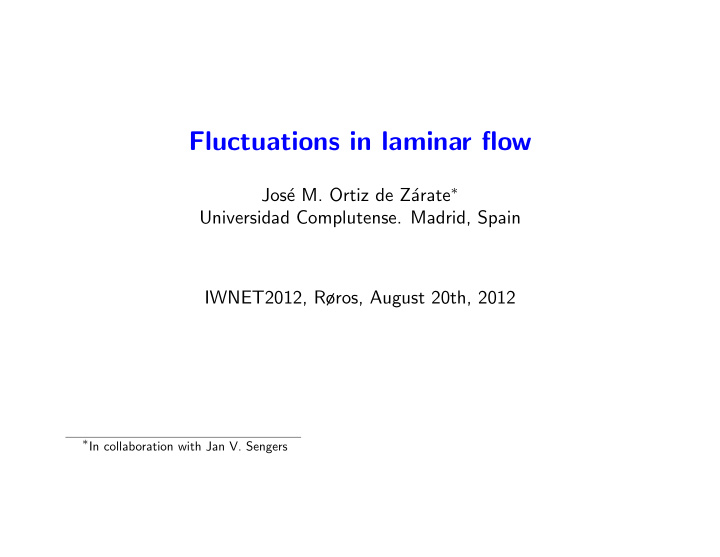



Fluctuations in laminar flow Jos´ e M. Ortiz de Z´ arate ∗ Universidad Complutense. Madrid, Spain IWNET2012, Røros, August 20th, 2012 ∗ In collaboration with Jan V. Sengers
Hydrodynamics Balance of momentum: ∂ ∂t ( ρ v ) = − ∇ [( ρ v ) v ] + ∇ Π − ∇ p + f V Entropy production: S = 1 ˙ T Π : ( ∇ v ) Linear phenomenological laws (incompressible flow): η ( δ ik δ jl + δ il δ jk ) ∂v k � Π ij = ∂x l kl 1
Fluctuating hydrodynamics I • Dissipation is due to molecular collisions (interaction) • To reflect the random nature of these collisions, in fluctuating hydrodynamics dissipative fluxes are supplemented with stochastic contributions. For incompressible flow: Π ij = η ( δ ik δ jl + δ il δ jk ) ∂v k + δ Π ij ∂x l � ∂v i � + ∂v j = η + δ Π ij ∂x j ∂x i • Stochastic properties: � δ Π ij � = 0 , and fluctuation-dissipation theorem: � δ Π ij ( r , t ) δ Π kl ( r ′ , t ′ ) � = 2 k B T δ ( r − r ′ ) δ ( t − t ′ ) η ( δ ik δ jl + δ il δ jk ) 2
Fluctuating hydrodynamics II • Substituting into momentum balance, we obtain an stochastic Navier- Stokes equation, with a δ Π forcing term. For incompressible flow and no volume forces: � ∂ v � = − ∇ p + η ∇ 2 v + ∇ δ Π ∂t + ( v · ∇ ) v ρ 3
Plane Couette flow I Solution of the deterministic equation wall-normal (z) = ɺ γ spanwise (y) v z 0, x L streamwise (x) L 4
Plane Couette flow II • Studying velocity fluctuations around the plane Couette flow, in the usual way, we obtain stochastic Orr-Sommerfeld and Squire equations for wall normal velocity δv z and vorticity δω z fluctuations: ∂ t ( ∇ 2 δv z ) + z∂ x ( ∇ 2 δv z ) − 1 Re ∇ 4 δv z = {∇ × ∇ × ∇ δ Π } z − 1 Re ∇ 2 δω z = {∇ × ∇ δ Π } z ∂ t ( δω z ) + z∂ x ( δω z ) − ∂ y δv z • Problem: deduce the fluctuations of fields � δv z ( r , t ) δv z ( r ′ , t ) � and � δω z ( r , t ) δω z ( r ′ , t ) � from the stochastic properties of the thermal noise. • Non-equilibrium enhancement due to mode-coupling 5
Nonequilibrium enhancement of thermal noise In nonequilibrium systems thermal noise is generically amplified due to mode coupling. Illustration with a temperature gradient. • Fluctuations in δv z “mix” regions with different (local) temperature. • Advective term ∇ T 0 δv z in hydrodynamic T 0 equations. • Local version of FDT. • Problem: What are the fluctuations maximally enhanced? 6
Amplification of thermal fluctuations in plane Couette Most important effect: vorticity fluctuations enhancement due to coupling with Orr-Sommerfeld. 5 5 C (NE) Re=100 ( q || ) z 4 4 1.0 0.25 3 3 2.5 0.50 0.50 • Wall-normal vorticity q y fluctuations with 2 2 35 1.0 5.0 1.5 25 spanwise modulation 10 30 15 1 1 7.5 20 3.0 W (NE) 2.5 2.0 ( q || ) • When towed by the z 0 0 0 1 2 3 4 5 0 1 2 3 4 5 flow: streaks q x q x streamwise 7
Voticity fluctuations with spanwise wave vector 1 10 0 10 -1 10 (NE) ( q ) -2 10 ∆ W zz -3 10 -4 10 Spanwise wave vector -5 10 ( q x = 0 ), great simplification. Relatively simple analytical 0.1 1 10 100 expressions are possible. q 8
Thermal noise in real space Generation of streaks • Thermal noise adopts a streak form • Streaks are maximally amplified 9
Thank you for your attention!! To learn more. . . • J. M. Ortiz de Z´ arate, J. V. Sengers Hydrodynamic Fluctuations in fluids and fluid mixtures Elsevier, 2006 10
Recommend
More recommend